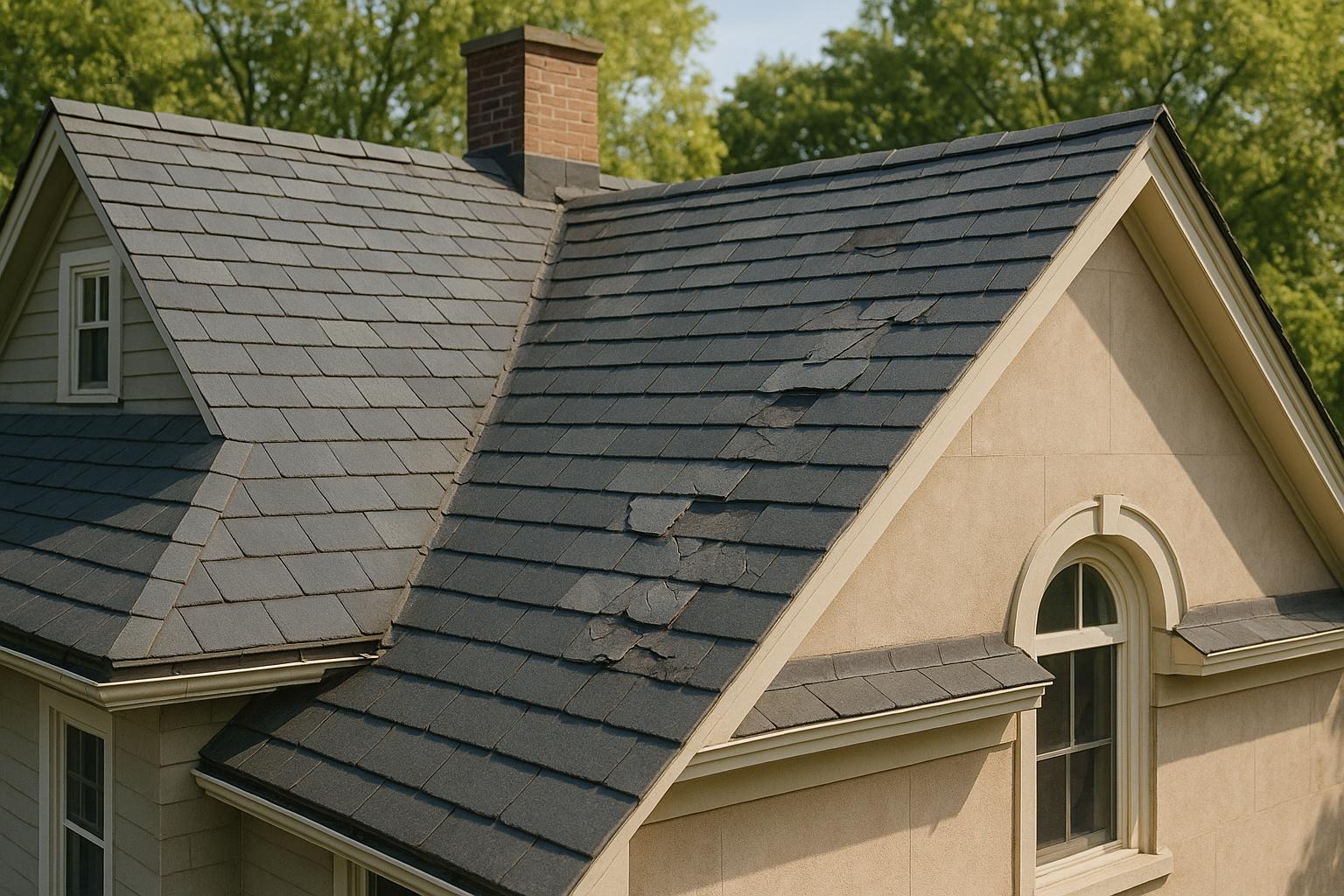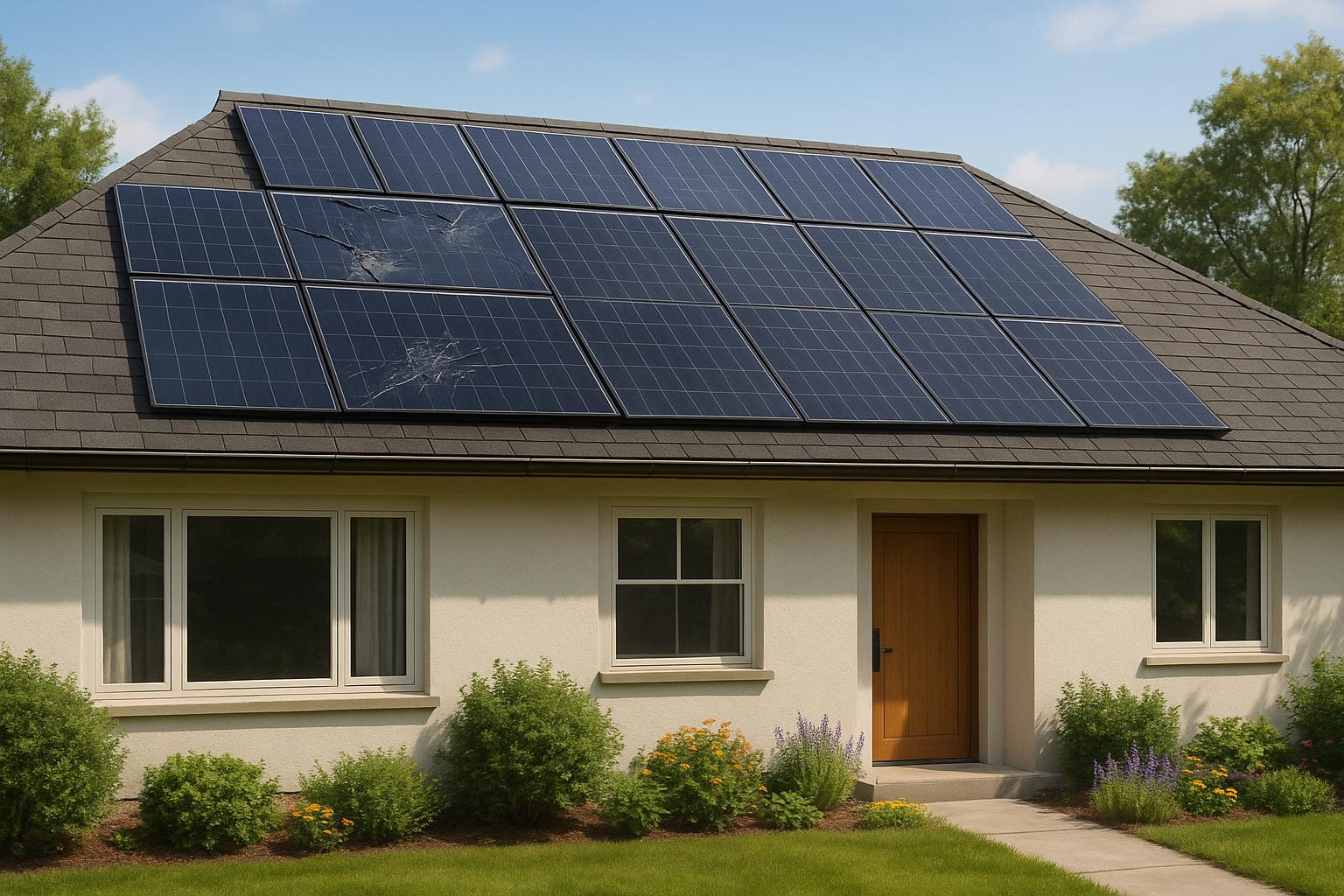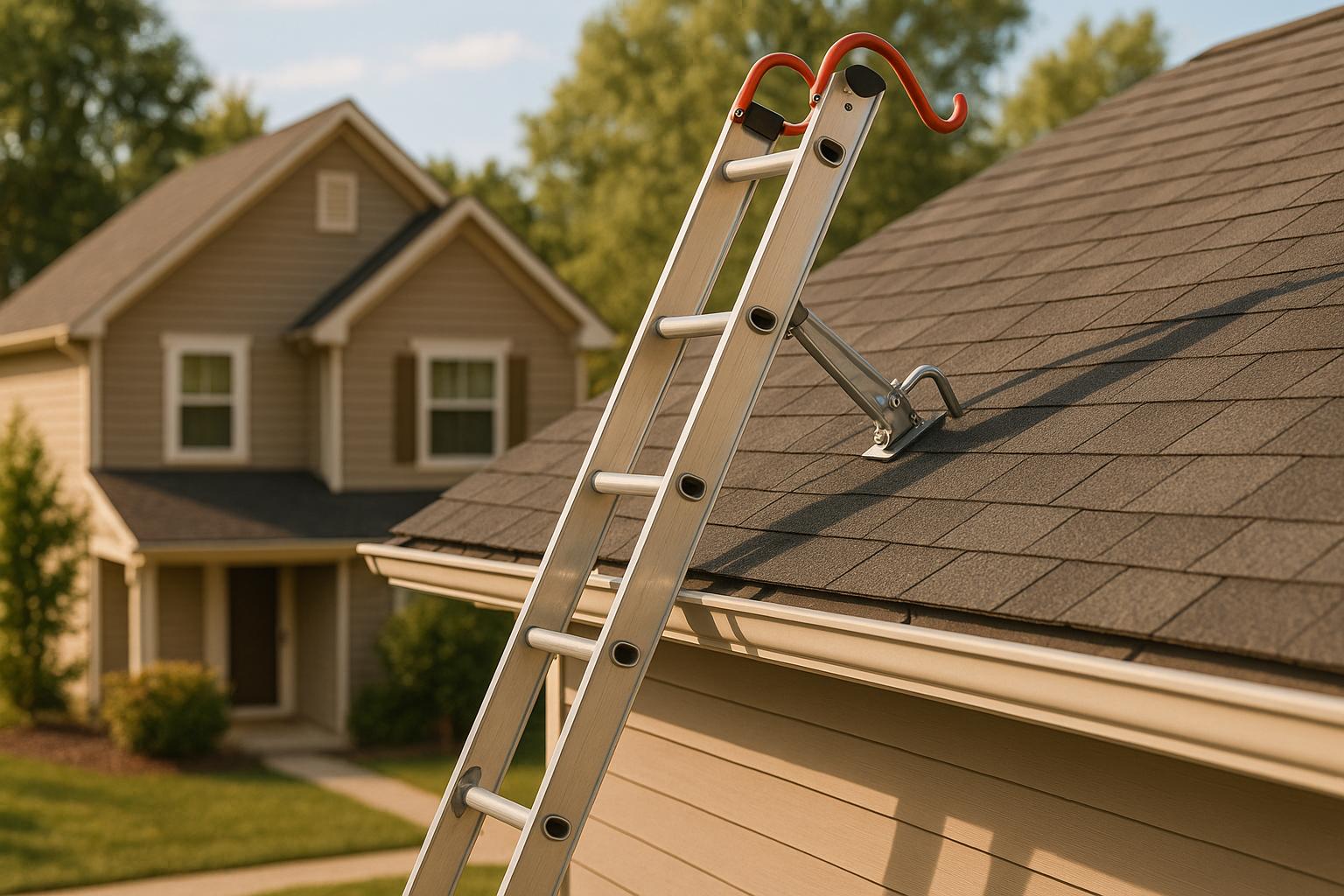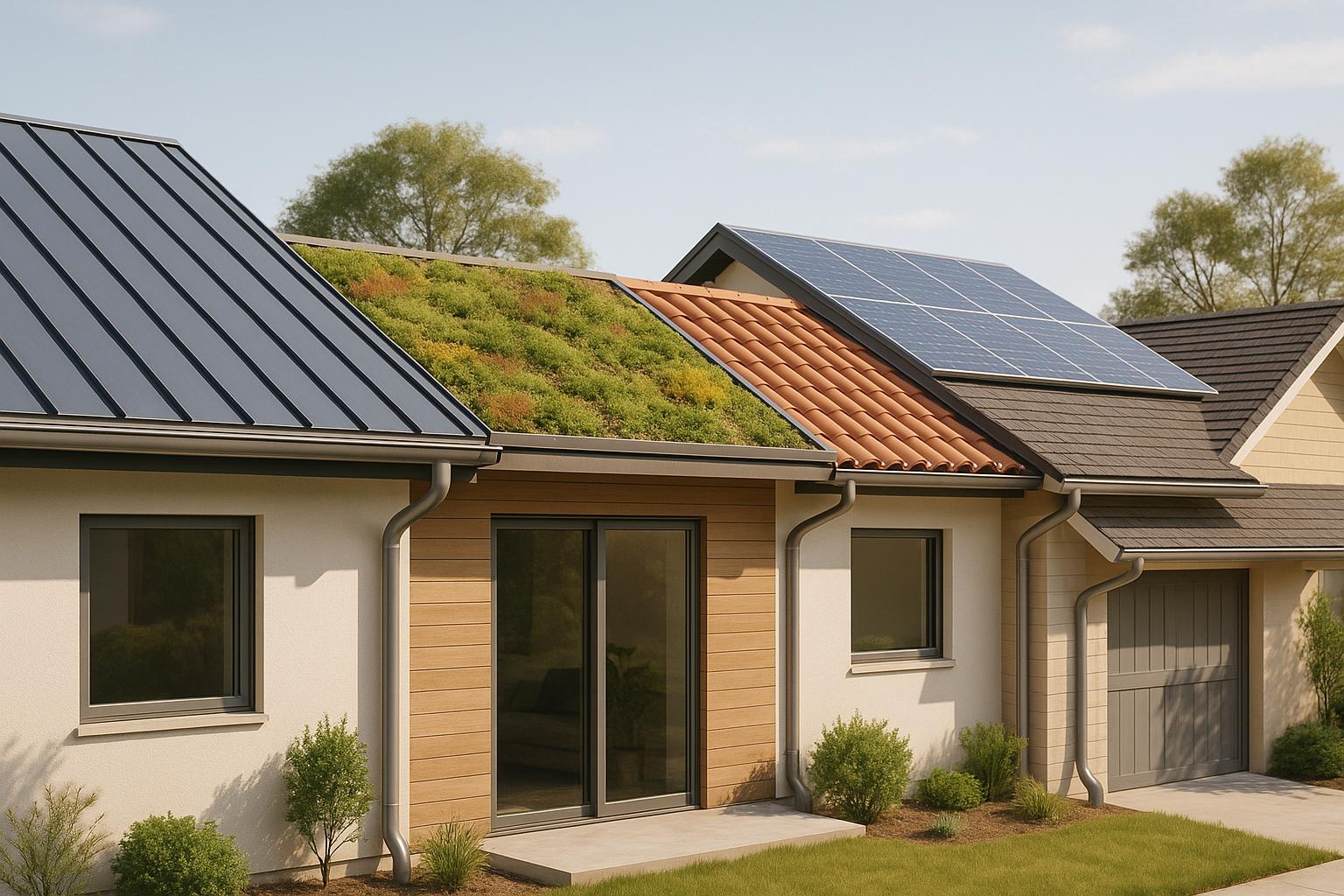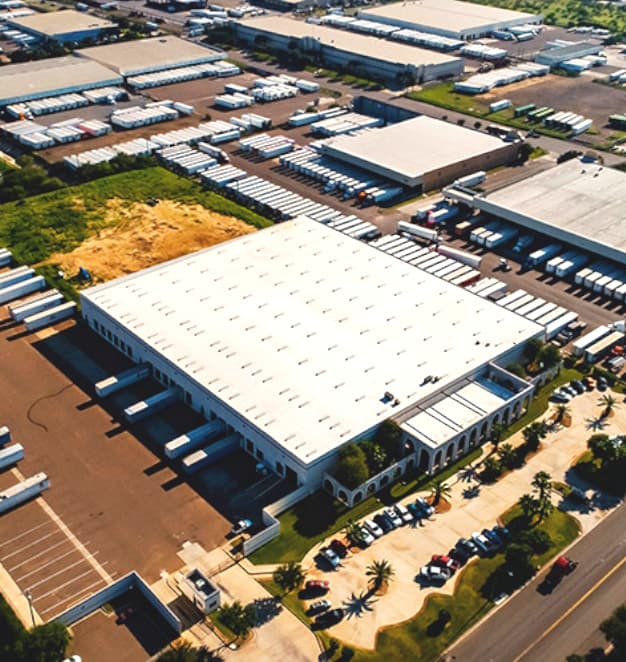Slate roofs are durable and long-lasting, but they’re not without issues. If you own a slate roof, here’s what you need to know to keep it in top shape:
- Common Problems: Cracked tiles, leaks, flashing deterioration, moss/algae growth, and nail fatigue are frequent issues.
- Fixes: Replace damaged tiles, repair leaks with proper sealants, clean moss and algae, and use corrosion-resistant nails.
- Prevention: Schedule regular inspections, clear debris, maintain gutters, and trim overhanging branches.
Why it matters: Proactive maintenance can save you thousands in repairs and extend your roof’s lifespan to over 100 years. Always leave structural repairs to professionals for safety and quality results.
Basic Slate Roof Repair
Common Slate Roof Problems
Slate roofs, while known for their impressive longevity, aren’t without their vulnerabilities. Even though they can last over a century, various issues can arise over time. By understanding these common problems, homeowners can address potential threats early and protect their investment. Below, we’ll explore some of the most frequent challenges slate roofs face in Los Angeles, including physical damage and installation errors.
Cracked or Broken Slate Tiles
Slate tiles are strong, but they’re not invincible. Extreme heat can cause the tiles to expand and contract repeatedly, leading to small cracks that may eventually break the slate entirely. Falling debris, such as branches or heavy objects, also poses a risk. As Cornett Roofing Systems highlighted in January 2025, even durable slate tiles – especially on older roofs – can sustain environmental damage when struck by debris, often requiring replacement. Foot traffic is another culprit; walking on a slate roof can cause tiles to crack or break due to their brittle nature.
Improper installation is a significant contributor to these issues. John Chan, CEO and industry expert, observed that "80% of the new slate roofs I’m called out to inspect have installation problems, improper head lap, improper side lap, or incorrect nailing". These installation flaws not only weaken the roof’s structural integrity but also make it more susceptible to weather-induced damage and water infiltration.
Leaks and Water Damage
Leaks in slate roofs often develop gradually, making them particularly tricky to detect. As RoofCrafters explains, "By the time a homeowner notices a leak, it might have been seeping into their home for weeks or even months". Poor installation practices are a common cause of leaks, as are aging roofing components. While the slate itself can last over 100 years, elements like underlayment, fasteners, and sealants typically degrade much sooner.
Weather events, such as heavy rain and strong winds, can also test the limits of even well-maintained roofs. Clogged or damaged gutters, for instance, can cause water to back up and seep under the tiles through small gaps, leading to water damage.
Flashing Deterioration
Flashing, which seals critical roof junctions like chimneys, valleys, and edges, is a major weak spot in slate roofing systems. In fact, flashing failure accounts for up to 60% of slate roof leaks. Made from materials like aluminum, copper, or steel, flashing is vulnerable to corrosion and loosening over time due to exposure to moisture, UV rays, and temperature changes.
Age and extreme weather conditions can further accelerate its deterioration. When flashing fails, water can infiltrate the roof’s most vulnerable areas, potentially causing structural damage and harming the interior of the home.
Moss and Algae Growth
Slate roofs, particularly those in shaded or damp areas, are prone to moss and algae growth. These organisms not only detract from the roof’s appearance but also trap moisture, which can lead to long-term damage and decay. Overhanging trees often create the shady, cool conditions that moss and algae thrive in. Additionally, poor drainage – caused by clogged gutters or insufficient roof slopes – can worsen the problem by allowing moisture to linger on the slate surface.
Nail Fatigue and Loose Fasteners
As slate roofs age, nail fatigue can become a pressing issue. Fasteners made from materials like iron or steel are prone to rust, which can cause them to fail and allow tiles to slip out of place. Thermal cycling, or the repeated expansion and contraction of both the slate and its fasteners, gradually loosens even properly installed nails.
Using the wrong type of fasteners during installation – such as standard roofing nails instead of those designed for slate – can lead to premature failure. Additionally, natural structural movement of the building may add stress to the fasteners, increasing the likelihood of loosened nails and water infiltration into the roof system.
How to Fix Common Slate Roof Problems
Understanding common slate roof issues is the first step to addressing them effectively. Each type of damage requires a specific repair method to ensure your roof remains both functional and visually appealing. Let’s dive into how to tackle these problems with care and precision.
Replacing Damaged Slates
When replacing broken slate tiles, you’ll need tools like a slate ripper, tin snips, a hammer, and slate trimmers. Safety is key, so secure your work area with scaffolding and a fixed ladder. Wear gloves, a hard hat, and rubber-soled shoes to protect yourself while working. Take your time to avoid damaging the surrounding tiles.
"Feed the hooked end of the slate ripper underneath Slate X (the slate you want to replace), and trap the nail in the hook. Hammer on the handle of the slate ripper to force the nail out of place, and then pull the ripper out. Repeat this process for the second nail." – JJ Roofing Supplies
Once the damaged slate is removed, carefully measure and trim the replacement piece as needed. Leave about a 1mm gap between the new slate and the surface to allow for proper expansion. To secure the new slate, you can nail a small lead strip to the batten and tuck it under the overlapping slate, or opt for copper slate hooks for a reliable hold.
Repairing Roof Leaks
Leaks can cause significant damage if not addressed quickly. Start by pinpointing the source of the leak – it’s not always directly above the visible water damage inside your home. For minor issues, a quality roofing sealant can serve as a temporary fix. For a permanent solution, replace the damaged tiles by following the same steps used for slate replacement. Cracked slates that haven’t completely broken can often be repaired with slate adhesive, which effectively seals hairline cracks. These methods will help maintain your roof’s durability over time.
Flashing Repairs and Replacement
Flashing plays a crucial role in keeping your roof watertight. Carefully remove old or damaged flashing without disturbing the surrounding slate tiles. Clean the area thoroughly before installing new flashing, choosing materials like copper or stainless steel for their resistance to corrosion. Ensure proper overlap and seal all joints with roofing cement. Test the repair by running water over the area to confirm that it redirects water away from your roof structure.
Cleaning Moss and Algae
Moss and algae can harm your slate roof if left unchecked. Start by gently brushing away loose debris, then apply a mild cleaning solution that’s safe for slate. Let the solution sit for about 30 minutes before rinsing with clean water at low pressure. Always spray downward to avoid forcing water under the slates. To prevent regrowth, install zinc or copper strips along the roof ridge. These strips release natural elements that inhibit moss and algae, helping to preserve both the roof’s appearance and its structural integrity.
Fixing Nail Fatigue
Over time, nails securing the slate tiles can rust or loosen – a condition known as nail fatigue. To fix this, carefully lift the affected tiles to access the compromised fasteners. Remove rusted nails entirely and clean the holes of any residue. Replace them with corrosion-resistant nails made of stainless steel or copper. Be mindful not to over-tighten, as this can crack the slate, while loose fasteners won’t hold securely. Check nearby tiles for similar issues since nail fatigue often affects multiple fasteners in the same area due to similar aging and weather exposure.
sbb-itb-d1d6490
Preventive Maintenance for Slate Roofs
Taking care of a slate roof can dramatically extend its lifespan, which ranges from 75 to 200 years. Nearly 80% of premature roof failures stem from avoidable issues. With proper maintenance, you can keep your slate roof in top condition for decades.
Regular Roof Inspections
Scheduling professional roof inspections annually – and after severe storms – is key to catching problems early. Experts can identify cracked tiles, loose fasteners, damaged flashing, early signs of moss, and even damage caused by environmental factors like acid rain.
"Maintaining your slate roof’s integrity through regular inspections helps prevent leaks, extends its lifespan, and preserves your home’s value for decades to come!" – Benchmarkroofreports.com.au
While homeowners can spot obvious damage, such as missing or dislodged tiles, from the ground using binoculars, walking on a slate roof is a no-go. The weight of walking can crack the tiles, so leave detailed inspections to professionals who have the right tools and experience.
Once inspections are complete, the next step is managing debris and moisture to keep your roof functioning properly.
Debris and Moisture Control
Clearing debris like leaves and twigs every 3–6 months is crucial for preventing moisture buildup, which can lead to roof damage and leaks. Pay special attention to valleys, areas around chimneys, and roof edges where debris tends to collect. Blocked gutters can also cause water to back up onto the roof, so keeping them clear is essential.
Clean your gutters at least once a year to ensure water flows freely and doesn’t seep under the roofing materials. Additionally, make sure downspouts direct water away from your home’s foundation to prevent further issues.
Overhanging branches are another source of trouble. Trim them back to reduce debris on the roof and minimize the risk of damage from falling limbs. Cutting back branches also increases sunlight exposure, which helps dry out damp areas and discourages moss and algae growth.
Monitoring for Moss and Algae
Keep an eye out for moss and algae, especially in shaded or damp areas, as they can weaken your roof and affect its appearance. If cleaning is necessary, stick to soft brushes or low-pressure water methods – power washing is too harsh and can damage the tiles. Use a soft-bristle brush to gently loosen moss and algae. For tougher growth, consider using roof-safe chemical solutions, and always follow the manufacturer’s instructions carefully.
To prevent moss and algae from coming back, install zinc or copper strips along the ridge. These metals naturally inhibit growth when rainwater washes over them. Trimming nearby trees to allow more sunlight to reach the roof also helps reduce the need for frequent cleaning. These small steps go a long way in protecting your slate roof’s durability and appearance over time.
When to Contact a Professional
Some slate roof issues require professional attention to ensure your safety and protect your investment. Spotting these warning signs early can save you from expensive repairs down the line.
Problems That Call for Expert Assistance
Certain signs make it clear that it’s time to call in a professional. Issues like water stains, sagging rooflines, or loose and missing nails are red flags that need immediate attention. Damaged flashing around chimneys, vents, or roof edges is another issue best handled by experts to prevent leaks.
If your slate roof is over 50 years old, an expert evaluation is essential. Similarly, a sudden spike in energy bills might indicate that roof damage is compromising your home’s insulation. When more than 20% of the slates require replacement, professionals often recommend a full roof replacement to ensure consistent protection.
It’s also worth noting that slate roofs are steep and slippery, making them dangerous to walk on. Attempting repairs without the right equipment and training can lead to cracked tiles or worse. Professionals have the tools and expertise to handle these challenges safely.
These situations highlight the importance of relying on qualified professionals for slate roof repairs.
Prime American Roofing Services
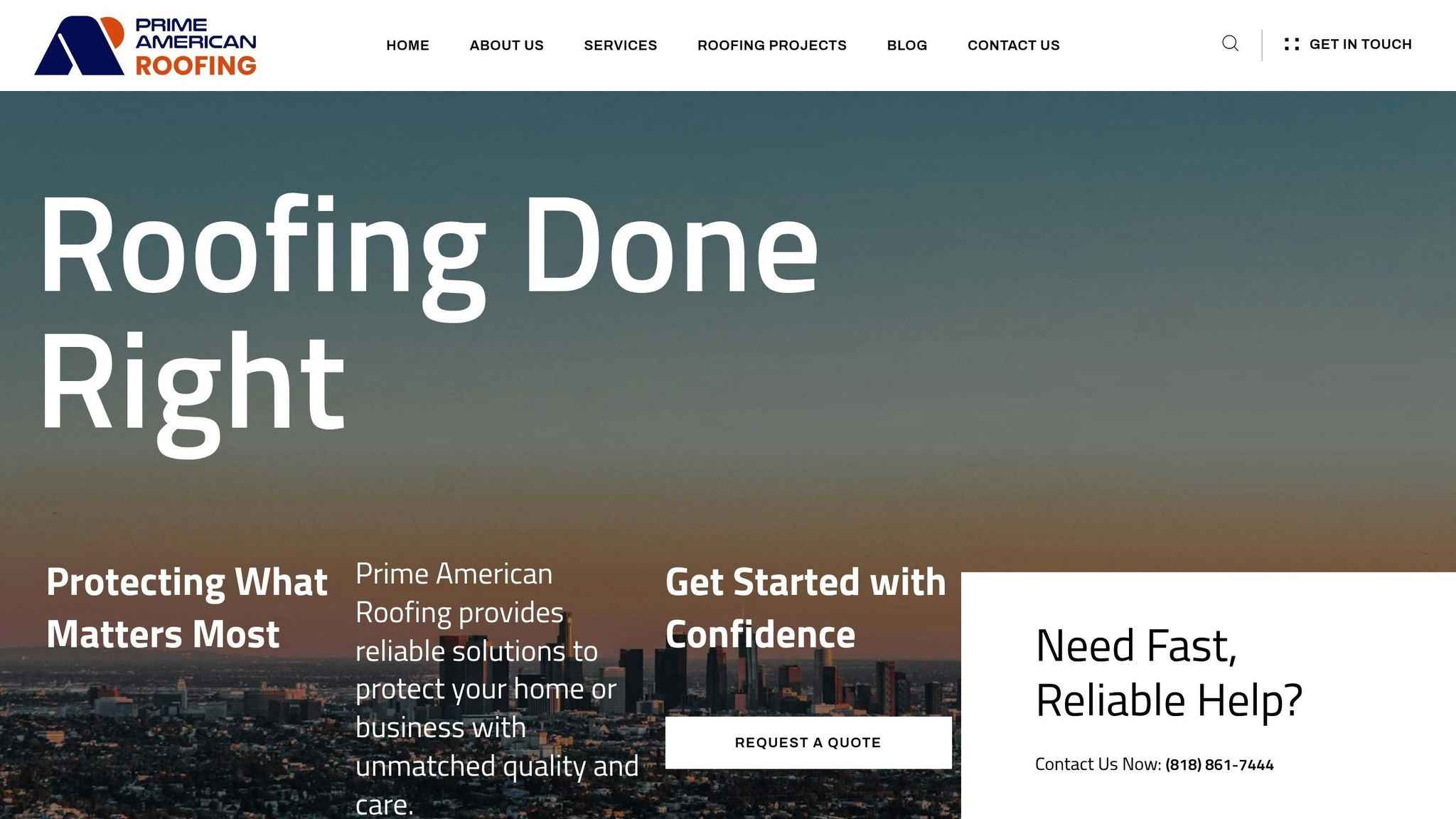
When serious roofing issues arise, having a skilled team on your side is crucial. Prime American Roofing is a trusted name in slate roof repairs and maintenance across Los Angeles. With a BuildZoom score of 114, they rank higher than 98% of California’s 336,931 contractors, reflecting their dedication to quality craftsmanship.
Prime American Roofing provides a full range of slate roofing services, including repairs, maintenance, and detailed inspections. Their team is licensed, bonded, and insured, ensuring a thorough and professional approach to every project. They hold a $25,000 bond and are licensed under number 1122250.
"Working in a professional and responsible team is essential for delivering high-quality roofing services. Collaboration ensures that each aspect of the project, from initial assessment to final installation, is executed with precision and expertise." – Tony Mirzakhanyan, Head of Prime American Roofing
The company’s reputation for customer satisfaction speaks for itself. They maintain a perfect 5.0 rating on both Angi (17 reviews) and Yelp (10 reviews), with clients frequently praising their professionalism, quality workmanship, and punctuality.
Their recent projects showcase their expertise and attention to detail. For example, in December 2024, Koresh R. hired Prime American Roofing for a $14,000 roof replacement. He shared that "the team walked him through every step of the process and the installation was completed on time and exceeded his expectations".
Prime American Roofing also offers free initial inspections, giving homeowners the chance to evaluate their roof’s condition without any upfront costs. Their typical project permits average around $16,870, and they’ve successfully completed at least five projects in the past year, demonstrating consistent reliability and skill.
Their approach focuses on careful material selection, matching existing slate types, and using proper installation techniques to ensure your roof’s longevity. By choosing experienced professionals like Prime American Roofing, you can avoid the costly mistakes often associated with DIY efforts or inexperienced contractors.
Conclusion
Taking care of slate roof issues early is a smart way to protect your home and avoid hefty repair bills. Small problems, if left unchecked, can quickly spiral into major expenses. Acting quickly can save you thousands of dollars in the long run.
Spending $200–$500 annually on regular maintenance is a worthwhile investment when you consider the alternative – repairs that could cost thousands. Plus, with proper care, a slate roof can last more than 150 years.
"Maintenance helps you tend to roof problems as they occur, allowing you to repair issues before they worsen. Improper maintenance can escalate damage to the point of requiring roof replacement. Proper slate roof upkeep leads to slate roof longevity." – Cornett Roofing Systems
As mentioned earlier, every proactive measure you take contributes to the long-term durability of your roof. Timing is crucial. Fixing minor issues right away prevents them from spreading to other parts of your home, like the attic, insulation, walls, or foundation. Emergency repairs, which often carry higher costs, can be avoided with consistent upkeep.
Routine inspections, paired with quick professional repairs, are the best way to stop small problems from becoming big ones. While homeowners can handle simple tasks like clearing debris, structural repairs should always be left to experts who understand the intricacies of slate. This mix of regular checks and professional care ensures your slate roof remains strong and reliable for years to come.
FAQs
What are the early warning signs of slate roof issues, and how can I spot them before they worsen?
Spotting issues with your slate roof early can save you from expensive repairs later. During your regular checks, keep an eye out for cracked, chipped, or missing tiles. Another simple test? Gently tap the slates. A dull sound instead of a clear ring might mean the slate is damaged.
Inside your home, pay attention to water stains on ceilings or walls, as these could point to leaks. On the roof itself, watch for signs like discoloration, moss or algae growth, or a powdery residue. These could mean the slate is starting to break down. Tackling these problems right away can help protect your roof and avoid bigger issues in the future.
Why should you use corrosion-resistant nails for maintaining a slate roof?
Using corrosion-resistant nails, such as stainless steel or copper, plays a key role in extending the life and reliability of a slate roof. These materials are designed to withstand rust and corrosion, ensuring the nails stay strong and secure even when exposed to moisture and tough weather conditions.
By resisting rust, these nails help keep the roof’s structure intact, lower the chances of tiles coming loose or failing, and cut down on the need for frequent repairs. Choosing the right nails is a small but impactful decision that can save you both time and money while keeping your slate roof in top shape for years.
How often should you have a professional inspect your slate roof, and why is it important?
Regular check-ups by a professional are key to keeping your slate roof in good shape. These inspections can catch problems like cracked tiles, loose slates, or leaks early, helping you avoid expensive repairs and making your roof last longer.
Experts suggest having your roof inspected once a year. It’s also smart to schedule an inspection after harsh weather, like heavy rain, hailstorms, or strong winds, to make sure everything is still intact. Staying ahead with maintenance can spare you the hassle, expense, and worry down the road.

